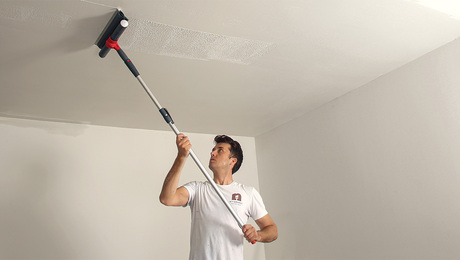Why can’t GE make a caulking tube that won’t allow the caulk to dry in the nozzle.
It is so frustrating I do small jobs so I usually don’t use a whole tube. The caulk is or was fine in the tube but it couldn’t get past the ‘plug’ in the nozzle.
We Pay five dollars for a tube of caulk only to possibly throw away 80% of it.
We can’t keep our caulk from becoming useless, but just this morning a spaceship with 6 or 7 people on it came hurtling out of space, at blinding, scorching speed and landed on a tiny little landing strip which yesterday the astronauts couldn’t even see. Tomorow we will probably shoot downa a dying satellite, and I can’t get some caulk to stay good.
Aahh, at least it was a pretty nice day here.
Webby















Replies
Webby,
Here is what to do: Slit the spout longitudinally with a knife down one side to very near the base from the tip. Dig out the hardened caulk with a 16d nail. Tape the nozzle back together with vinyl electrical tape. You are in business, ready to use the next 20% of that tube.
Next time, simply untape, dig out, retape and go.
Bill
Hey I'll try that. Thanks.
p.s. Does it have to be a 16d?
Peach full,easy feelin'.
15D, 17D whatever ya have.Spheramid Enterprises Architectural Woodworks
"Success is not spontaneous combustion, you have to set yourself on Fire"
I've tried a half dozen methods over the years. This tip sounds like a sure shot. thanks!
Edited 2/20/2008 11:19 pm ET by OldGuy
I use these http://www.littleredcap.com/
Might not be the "rocket science" you seem to be looking for, but, they work
Edited 2/20/2008 5:11 pm by Shoeman
I use those caulk rubbers, too. After a long enough time I still have to dig out the hardened spout.
Yep, I use them.
Worth a few chuckles around the job site too.
I've heard more than a few comments about keeping one in my wallet.
View Image
Are you embarrassed to buy that size?
I've had pretty good luck with using the super thin metalic foil tape over the tip, joined at the sides and leave a little reservoir at the tip and squeeze a honker of caulk into it.Also found some great blue caulk tube condoms - really thick - not like the red ones - they worked really good - found em at a kitchen counter supply house - should've got more, I'm all out of them now.JT
I screw a long 2" to 3" screw into the tip, coarse thread. When I need it again, I just pull the screw out and all of the dried stuff comes out with the screw.
Thanks everyone I will try the suggestions.
After I threw out two tubes I called the GE people and gently complained. I suggested they use a screw on replaceable nozzle. She said that she understood and a lot of people complain about that. She said they are looking at different options. Whatever that means. It wouldn't be so bad if the stuff didn't cost five bucks a tube.
Webby
I hear ya. A while back, I threw out about two 5 gal buckets worth of tube 75% full with frozen tips.
Construction adhesive is the worst offender. For awhile I was buying CA in toothpaste like tubes with screw on caps.
Someone must have told the manufacturer how good they are cause I cant find them anymore.
I had to waste a tube of CA today for three squirts to install an access panel.
I buy Tremco 'mono' in those little squeeze tubes.
4 bucks but the stuff lasts for months.
Gord
"Why can't GE make a caulking tube that won't allow the caulk to dry in the nozzle."
"We Pay five dollars for a tube of caulk only to possibly throw away 80% of it."
It isn't often that one asks a question, and then answers it, in the same post...
Yeah, it may be cold, but at least it's a wet cold !
Couldnt believe it ...I was at Lowes and i asked " do u have those lil rubbers for caulk tubes?..and next think i hear on the PA.."Customer in paint needs lil rubbers !"Guess i be at Home Depot for awhile.
Large (red or grey) wire nuts... works every time.PaulB
>>Large (red or grey) wire nuts... works every time.Not for long.JT
GE must not be in a big hurry to fix the problem seems caulk tubes have been around since?? the 60s??
I dunno JT... I've had tubes last a couple months with this technique which is all I need anyway.PaulB
I use 2" wide clear packing tape. Wrap the tip, pinch the end of the tape together and squeeze a little caulk into the tape. Don't squeeze so much that you open the end. I've had caulk last for months.
You could use aluminum tape like another poster suggested. I like the clear tape because I can see what the caulk is doing.
Try putting a nail or screw in the end and then wrap it with duct tape. That seems to keep it flowing for awhile